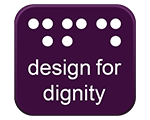Guidance on premises
Tactile Ground Surface Indicators
TGSIs are a visual and tactile aid that allows people who are blind or vision impaired to orient themselves and make sense of other environmental clues. They would most commonly be used in the shopping centre itself, as most stores don't have the types of potential hazards that TGSIs assist with.
Overhead obstacles, or those which protrude in a way that a person using a cane would not perceive, should be avoided within the store rather than marking out with TGSIs internally. TGSIs, whilst serving a critical purpose for people who are blind or have low vision, also create a more difficult surface for people with mobility restrictions.
Design focus
Hazard or warning TGSIs (Round)
- They are to be placed across the full width of the direction of travel at the top and bottom of stairs, ramps, escalators and moving walks and to highlight overhead obstacles.
- They should be between 600mm and 800mm deep and set back 290mm to 310mm.
- The TGSIs themselves must be made according to a specified design and arrangement standard (height no more than 5mm above base, dot spacing at 50mm, slip resistant, high luminance contrast and no likelihood of edges lifting).
Directional TGSIs (Strips)
- Used to designate a route to be taken to avoid a hazard or to indicate a path of travel across an open space. They are prescribed for application in transport settings.
More information on TGSIs can be found in AS 1428.4.1.*AS 1428.4.1 Design for Access and Mobility Part 4.1: Means to assist the orientation of people with vision impairment — Tactile ground surface indicators.
Additional consideration
- It is tempting to ‘over-use’ TGSIs in an effort to over-comply. The Standards themselves note that a person may “become disoriented if presented with an unpredictable, incorrect, incomplete or over-supplied set of indicators”.
- Maintenance of TGSIs is often neglected and should be incorporated as part of regular property maintenance reviews.
- Ensure that the luminance contrast of TGSIs is high against the background upon which they are laid.



